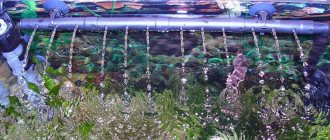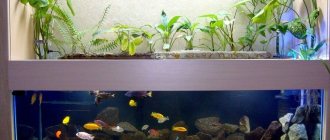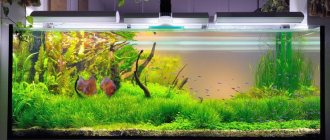Many modern people like to keep aquarium fish in their homes. Cleaning the soil is one of the most important procedures in caring for fish housing. To facilitate this process, special devices are used, for example, “vacuum cleaners”, which can be purchased in stores, but they are not cheap. If you wish, you can make a siphon for an aquarium with your own hands, significantly saving the family budget.
The cleanliness of the aquarium, in particular the soil, directly affects the health of the fish.
How the device works
In simple terms, a siphon is a regular pump. In general, it is a device for pumping out liquid. For example, water will be pumped out of an aquarium along with fish waste.
The main part of the tool is presented in the form of a suction tube. The principle of operation of a siphon for aquariums is very simple: one end of the tube is lowered tightly to the ground, and the second is placed as low as possible in relation to the level of the bottom of the aquarium. The outer tip is dipped into a jar or bucket. It is necessary to create a vacuum in the pipe, but this is a fairly simple procedure, similar to pumping gasoline out of a car using a rubber hose. Vacuum is created by sucking air through the mouth. Similar manipulations are carried out to launch a siphon in an aquarium.
The siphon makes cleaning the soil in the aquarium much easier
The liquid along with the waste will flow by gravity into the pipe and drain into a pre-prepared container. As a result, you need to wait until the dirt settles and drain the water back into the aquarium. The process is not particularly difficult. The auxiliary devices of commercial siphons for cleaning aquariums can be considered the result of scientific developments.
https://youtube.com/watch?v=QtjnjLJkLD4
Methods for cleaning the soil in an aquarium using a siphon, as well as practical tips
When keeping any type of aquarium fish and other animals, it is important to keep the aquarium clean. Proper and timely cleaning of the soil and water in the aquarium is one of the integral components of caring for swimming pets.
Which type is better
A siphon is an accessory that is difficult for any aquarium owner to do without. All the inhabitants of the aquarium release their waste products into the environment, the decomposition of which can release rotting products - poisonous gases hydrogen sulfide and ammonia.
Important! These gases are harmful to all living organisms in the aquarium.
If in large natural reservoirs this does not have a significant impact on the health of fish and other animals, then in an aquarium, even a large one, the soil must be regularly cleaned of bottom sediments - fish excrement and silt. In this way, you can clean the filler in the form of sand, pebbles, black types and other varieties.
Types of siphons
Today there are many different types and models of siphons on the shelves of specialty stores. Their operating principle is identical, the difference is in the types of drive, power supply and the availability of additional options. Depending on the type of drive, the devices are:
- Electrical. In addition to the standard components in the form of a tube and a glass, this device has a pump that operates from the mains or using batteries. It is with the help of the pump that the waste is collected. All waste goes into a special pocket, and clean liquid is returned back to the aquarium. The device is convenient to use, does not harm plant roots, and has high power. However, there are a number of disadvantages: the device is fragile, requires frequent replacement of batteries, and is expensive.
The electric siphon has a pump for collecting debris from the ground
- The mechanical device operates by gravity. It contains a funnel, a hose and a glass. The pressure depends on the width of the hoses and funnel - the narrower they are, the greater the force with which the liquid is suctioned. Many models are equipped with bulbs, with the help of which pumping begins. This siphon is quite easy to use, does not require special skills, is suitable for processing any aquarium, and is accessible to everyone. The disadvantages include the impossibility of adjusting the power of liquid flow and the difficulty of working in places where algae accumulate. In addition, an auxiliary water collection tank is required for subsequent filtration.
In fact, the design is quite simple; if you wish, it is quite possible to make a homemade device at home.
Mechanical siphon suitable for all aquariums
How to siphon soil correctly
Cleaning the soil is an important process on which the well-being of the inhabitants of the tank depends, so it is important to know how to clean an aquarium with a siphon correctly. To begin with, you should understand that cleaning will take more time - about an hour, because you will have to siphon the entire area, otherwise cleaning will not make sense. If a mechanical type device is used, the volume of drained liquid should not be more than 30%. After cleaning, the amount of drained water is compensated by fresh and clean liquid.
Large funnels are used to clean the middle of the aquarium, and triangular nozzles are suitable for the corners of the tank.
For aquariums with many plants, it is better to choose a special model of cleaners, which are sold in specialized stores, since powerful siphons powered by electricity will cause damage to the roots of the flora.
In the question of how to siphon soil correctly, general recommendations will help:
- the end of the device tube is lowered from the outside below the bottom of the vessel with fish;
- when using a high-power cleaner, you must ensure that the device does not suck in small fish;
- the lower the tube is placed, the more powerful the jet pressure will be;
- special siphons are used for nanoaquariums;
- the deeper the funnel is lowered into the ground, the better the substrate will be cleaned;
- When choosing a soil cleaner, the dimensions of the reservoir, the type of substrate, and the amount of flora and decorations are taken into account.
DIY making
You can make a soil cleaner for an aquarium with your own hands from scrap materials that you probably have in any home. To create a purifier you will need:
- meter hoses (its diameter is no more than 5 mm);
- plastic bottle;
- 2 syringes for 10 cubes;
- insulating tape;
- brass hose outlet;
- knife.
A device for cleaning the soil in an aquarium can be made from scrap materials.
You need to remove the pistons from the syringes and remove the needles. Using a knife, cut off all the protrusions from one syringe to create a tube. From the second, remove the part into which the piston fits with a knife. Make a hole with a diameter of 5 mm in the place where the needle is attached. Connect the resulting tubes together using insulating tape. It should be noted that the part of the syringe with the hole should be on the outside , then thread the hose into it. Cut a hole with a diameter of 4.5 mm in the bottle cap and insert a brass part for the hose outlet into it. Connect the other end of the hose to the outlet. The siphon for soil with your own hands is ready.
Instructions for use
So, after the siphon is ready, you can check it in action. Cleaning must be carried out at least once every 30 days. During this period of time, food residues, fish waste, and dead plants will have time to accumulate at the bottom of the aquarium.
In order for a do-it-yourself aquarium siphon to work, you need to immerse the funnel in the aquarium, and lower the other end into a pre-prepared container to collect dirty liquid. You can run the cleaner using several methods:
- Use your mouth to draw the liquid through the hose, and then it will flow into the container on its own.
- Submerge the funnel completely into the aquarium, closing the drain hole, then lower it into the container, and the liquid will flow on its own.
A homemade cleaner can be launched either with your mouth or with a pear
- You can resort to using a medical bulb. To do this, you need to pump air into it several times from the drain, and water will begin to flow at the return.
You need to start cleaning from places that are free from plants. First you need to place the funnel in the ground and rock it so that the dirt rises from the very bottom. Heavy soil will sink back, and light soil will flow out along with the water.
Carry out manipulations until the water becomes clear. Then move the funnel to another place and carry out similar actions. Continue the procedure until the entire perimeter of the aquarium is clean.
At the end of the work, you need to add water to the aquarium to the original level. You can use both pure liquid and settled liquid after filtration.
Why do you need to siphon the soil?
Before you learn how to use an aquarium siphon, you need to understand why you need a soil cleaner. The fact is that fish living in an artificial reservoir leave waste from their vital activity, and the tank is also clogged with the remains of food and dead plants. All these substances settle at the bottom, mixing with the substrate, and if you do not use a special device for cleaning, the soil will soon become acidic, and harmful bacteria, accumulations of ammonia and hydrogen sulfide will form in it, which are dangerous to the health of pets. Previously, aquarists had to clean the tank by removing the substrate completely from the water and rinsing it, but this was a difficult and time-consuming procedure. Therefore, a special device was created - a siphon for cleaning soil, which will quickly and safely remove dirt. People who are faced with the phenomenon of cleaning a tank for the first time think about how often to siphon the soil. This question is individual, since the frequency of cleaning depends on the degree of pollution and the size of the reservoir: some owners siphon the substrate every week, others once a month.
Cleaning and storing the device
A DIY siphon is very easy to maintain and clean. Upon completion of cleaning the aquarium, you need to disassemble all parts and rinse thoroughly under running water. If desired, you can use a soapy solution to wipe down the funnel. After this, you need to rinse it well and dry it thoroughly with a cloth. It should be noted that all detergents can harm fish, so you need to thoroughly rinse all parts of the structure.
As needed, for example, when dirty stains are no longer washed off or deposits clog the hose, you can replace it or make a new design. Cleaning the soil in an aquarium using a siphon is a very important procedure that does not take much time and effort. To clean a structure with a capacity of 50 liters, 10-15 minutes are enough. The benefits of such a homemade device are invaluable.
average cost
As of February 2021, the average price of equipment in online stores is:
GC-30 620 rub.
GC-40 890 rub.
GC-50 990 rub.
The manufacturer supplies spare parts for siphons, the customer can purchase a new hose or tube sections. The cost of Tetra components is comparable in price to new equipment; a number of customers note a long delivery time for parts.
Review of professional equipment
Today, manufacturers of equipment for aquarium maintenance offer a large selection of siphons for cleaning soil of various types: cheap and expensive, mechanical, electrical, of various capacities, with sedimentation tanks and special valves. It is difficult to decide, at first glance, which device to give preference to. The main thing when choosing is not to rush and determine a specific model that is suitable for a particular case. Popular brands of cleaning equipment:
- EHEIM. If the aquarium owner prefers high-tech systems, then he will like the famous German products. The battery-powered electric device weighs 630 g. Despite its light weight, it effectively cleans the aquarium without draining the liquid. He immediately returns the purified water. The suction tube has serrated perforated edges. This is necessary in order to preserve the roots of the plants. This device is designed for containers up to 200 liters, the height of which is no more than 50 cm. The disadvantages of the device include the high cost and rapid discharge of the batteries. The last problem can be solved by installing an adapter so that the power comes from the electrical networks.
Electric siphon from the German company EHEIM is lightweight and efficient
- HAGEN is a company from Germany that is a leader in the production of cleaning siphons. The company has an extensive line of its products, the prices of which are not affordable for everyone. The electric device Hagen Marina Aqua Vac carefully and efficiently cleans the soil at the bottom, and also allows you to change the water using a 7-meter hose included with the device. The cost of this device is very high and amounts to about 6 thousand rubles. If purchasing a device is too expensive, you can buy a compact device from this company, which can be launched using a rubber bulb. In addition, to collect liquid you will need a container that needs to be installed below the aquarium. The cost of such a device is no more than 600 rubles.
- The Tetra company produces siphons of different capacities. Cost varies, but in general these cleaners are budget-friendly and high quality.
- AQUAEL. Many experts praise this Polish company. It creates lightweight and effective siphons for the soil in the aquarium. This company has been competing with German companies for a long time. Their big advantage is the low cost of production.
The choice of manufacturer depends on the budget and preferences of the buyer. Cleaning an aquarium is an important procedure for maintaining normal living conditions for its inhabitants. You can buy a special siphon ready-made or make it yourself and save a lot of money.










